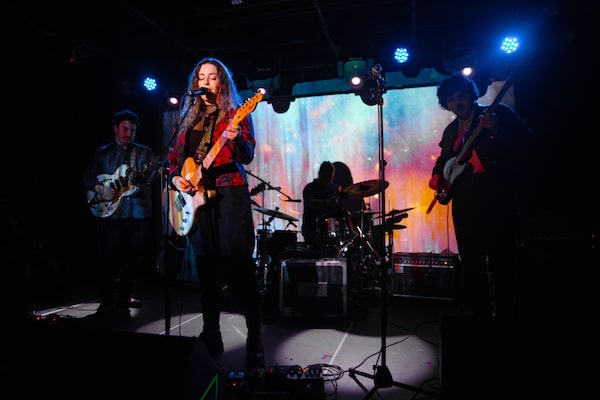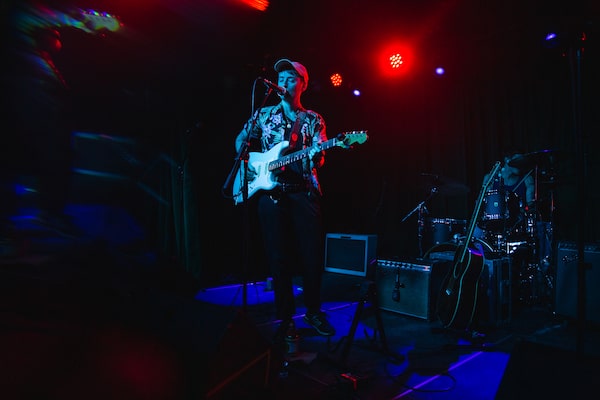
With excellent acoustics and first-rate treatment for artists, the Drake Underground has earned the music industry's respect.WendyWei/Supplied
When a flash flood overwhelmed the drainage system of Toronto’s Drake Hotel last August, Bill Simpson took a phone call at home from the boutique inn’s alarmed general manager. Toilets were exploding, geysers were erupting, and the sump pumps in the basement music club couldn’t keep up with the deluge. Within four minutes, the Drake Underground was under four feet of water.
“It was a catastrophe,” said Mr. Simpson, the chief operating officer. “But we had decent insurance. We shut the club down, rebuilt it, and it’s better now than ever.”
He would know: As the Drake’s unofficial historian, Mr. Simpson has been with the hotel since 2001, when the former Parkdale neighbourhood flophouse with a punk club and rave den in the basement was purchased by Jeff Stober.
A two-year, multimillion-dollar overhaul back then turned the rundown hotel into a thriving cultural hub and hip hostelry that has expanded its empire to include Drake-branded restaurants, bars and retail outlets across the city, as well as a rural outpost, the Drake Devonshire, in Prince Edward County.
Though shows have been taking place in the Underground for a few weeks, the official relaunch is set for Thursday, Feb. 7, the first day of a four-day party celebrating the hotel’s 15th anniversary.
The revival of the respected club – a launch pad for local music acts and an intimate venue for fast-rising international artists – sees it return to a music scene in flux. Clubs continue to be squeezed out by high rents, but another development has emerged: the gentrification of audiences.
“It’s requiring more creativity in booking music and to get people through the door and paying a cover,” said Shawn Creamer, who recently sold the Dakota Tavern, a successful roots-music venue he founded a dozen years ago. Where he and other Toronto club owners are able to get older music fans through their doors for early-evening concerts, they struggle to get younger audiences for the traditional late-night shows. “I need those 10 p.m. to 1 a.m. people to come in and buy alcohol, so that I can give the door money to the band,” Mr. Creamer said. “It’s unfortunate, but music has become devalued in the digital age.”
So where beer-soaked, standing-room clubs flounder, genteel rooms succeed. Look at the Burdock (which offers a brewpub, restaurant and intimate side room for calm music), Hugh’s Room Live (a supper club and folk-music haven that has successfully transitioned to a not-for-profit venue) and Drom Taberna (a lively restaurant offering Eastern European music nightly on Queen Street West).
“People want an adult experience,” said veteran programmer Derek Andrews, who helped resuscitate a sinking Hugh’s Room. “They want something social, beyond the standing-room venues.”
Read more
The top 10 most significant concerts in Massey Hall’s history, as reviewed by The Globe
The 6 best under-the-radar Canadian musicians of 2018
Grammy Awards 2019: Breaking down Shawn Mendes’s In My Blood, beat by beat

Fans of the 150-capacity Underground won’t notice much of a change.WendyWei
The trend toward more refined environments has hurt certain music genres. “The hip-hop scene is challenged for spaces to play,” said local promoter Jonathan Bunce. ”The spaces just don’t seem to be there.”
Mr. Bunce includes a rap component to his Wavelength Winter Fest (Feb. 15-17 at the Garrison), but other club owners are reluctant to present hip hop because of noise concerns and higher security costs.
Noise issues doomed the return of the historic, long-shuttered Matador Ballroom. After eight years of hassles with city hall over liquor licences and zoning – the century-old venue sits in a residential neighbourhood – owner Paul McCaughey recently gave up on the project, citing “investor fatigue." The Matador is currently for sale.
On the bright side, the long-promised revitalization of the El Mocambo seems to be coming into view, with the storied club’s trademark palm-tree signage reinstalled and relit in a ceremony last November.
All of which seems of little interest to the Drake Hotel brain trust, who’ve created their own scene within the city. “Honestly, we’re not that worried about other venues,” said Mia Nielsen, the Drake’s director of art and culture, who sees the downstairs music room as a kind of gateway drug to the hotel’s brand. “We’ll nurture our own venue, with the idea that the Underground is an entry point for the next generation of Drake patrons.”
Fans of the 150-capacity Underground won’t notice much of a change. Mr. Simpson gave The Globe and Mail a tour of the restored venue and pointed out an extra bar, an upgraded lighting system and a new modular stage.
(The bigger changes to the hotel are outside, with a large hole in the ground next door where three small buildings used to stand. Construction has begun on a 32-room expansion, with the annex set for a mid-2020 opening.)
Over its 15 years, the Underground has earned the music industry’s respect. The room’s acoustics are excellent, and the hospitality offered to artists is first-rate. Old-timers who caught Sloan in the hotel’s grimy basement in 1992 wouldn’t recognize the polished space, which has seen artists such as Sharon Van Etten, M.I.A., Leon Bridges and K’naan hop on its stage.
In addition to playing host to touring acts, the Underground has a reputation for its curatorial prowess.
“It’s a cozy little incubator of a room,” said Steve Jordan, founder of the Polaris Music Prize. “Chances are before a Toronto artist has landed on the Polaris long list, they’ve played the Underground.”
The programmers at Massey Hall – the historic theatre that is currently closed during its own restoration – use rooms such as the Underground for developing younger artists. “You can’t [overstate] the importance of having a quality small venue where an artist can make their debut, showcase new music and start building their audience,” said Massey Hall’s Jesse Kumagai. “Every city needs a room like that.”
 Brad Wheeler
Brad Wheeler